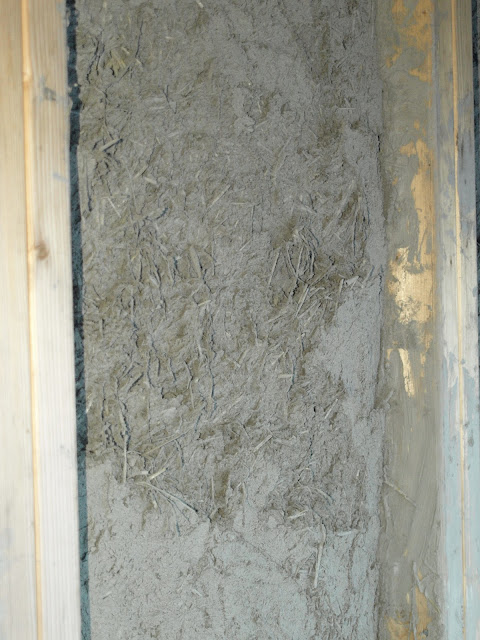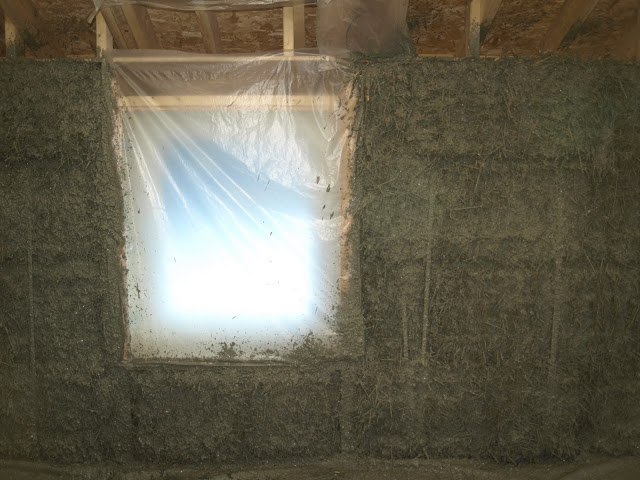Sunday, 27 February 2011
Thursday, 17 February 2011
Wednesday, 16 February 2011
Tuesday, 15 February 2011
Sunday, 13 February 2011
Day 304
More external rendering today. We finished the south elevation yesterday, and today we got from the road to the stair window on the north elevation.
We think the clay on the east (road) elevation has held up well under the poor winter weather conditions and does not need to be replaced. We will do some final inspections next weekend, but our fingers are crossed!
We think the clay on the east (road) elevation has held up well under the poor winter weather conditions and does not need to be replaced. We will do some final inspections next weekend, but our fingers are crossed!
Saturday, 12 February 2011
Another example of where the frost has blown off part of the previous coat of render. Whilst some of the render is still on the wall, it has lost its key to the render below. It was sole destroying but we had to knock a lot of it off, particularly at high level. If we hadn't knocked it off, it would have been pulled off by the application of the next coat of render.
Friday, 11 February 2011
Thursday, 10 February 2011
Day 301 - first part of the internal scratch coat
We completed the internal scratch coat on the internal side of the straw bales in what will be the utility / plant room. We will put studwork in front of this wall to fix all the plant back to shortly, so we want this to dry out quickly.
We have changed the mix of the clay render / plaster. On the dry external plaster, when the clay was aggravated it 'dusted off' the wall. This is undesirable, particularly on the internal walls, where we don't want a lot of plaster to end up on the floor everytime you touch the walls. To try and avoid this we ave increased the quantity of clay in the mix. The disadvantage of this is that will shrink more and may crack.
Wednesday, 9 February 2011
Day 300 - external rending resumed
We were back on the external rendering today. We started on the south elevation, which was the last area we rendered before the freezing weather. Since last year, some of the render had fallen off and a lot of it had lost its key from its backing and become very flaky and crumbly. We had to strip back a lot of the old render before applying the new coat, which will hopefully escape the sub-zero temperatures this time!
We completed half of the south elevation today.
Tuesday, 8 February 2011
Day 299 - Internal clay slip complete
The new power mixer was at least twice as quick to mix the clay slip and ten times more comfortable!
As a result we finished all the clay slip!
Having applied all the external clay slip by hand (rather than with the render gun), we reckoned it was about twice as quick with the gun. Working the clay into the straw by hand was also quite hard on the fingers. Having said that the gun was quite heavy to use for long periods of time!
We also had a go at applying the scratch coat with the gun (a mix of clay slip, sand and fibre). Externally we used chopped straw as the fibre, however we did not think this would go through the render gun. So we used hemp shiv instead. It did go through the gun, however it was not very quick and we concluded a reasonable plasterer could apply it faster by hand.
Monday, 7 February 2011
Sunday, 6 February 2011
The Limecrete Company kindly bought us some samples of their polished lime screeds today to have a look at. The aggregates vary and include some recycled materials and by-products of other industries, which together with the sand, produce very different effects.
Saturday, 5 February 2011
Day 296 - the render gun
The render gun is very fast at applying the render to the wall, the manufacturer suggests it covers about 1sq m in 10 seconds. Each hopper only lasts a matter of seconds (if the hopper were any bigger it would make it too heavy to hold for long periods of time).
The bottle neck we had was with the mixing. A barrow of mix took a few minutes to empty onto the wall, but took 15-20 mins to produce from soaked clay. We are hoping to improve on this - to date we have been using an old drill (1000W) with a paddle mixer on the end. We have been limited by the size of paddle the drill is able to turn (before you can start to smell the motor burning!). It is also awkward to hold for long periods of time and we have also managed to bend the paddle a few times, making the vibrations quite bad. However, we have now ordered a dedicated paddle mixer which we hope will turn up at the beginning of next week.
At the end of the first day of rendering we completed the slip coat on 1/2 of the ground floor walls.
Subscribe to:
Comments (Atom)


























